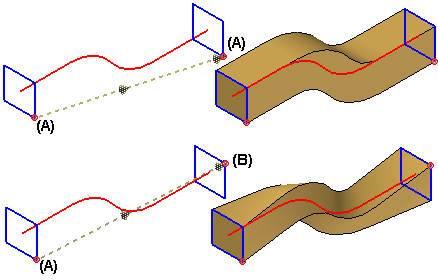For swept protrusions and cutouts, the cross sections must be closed profiles that can be planar or non-planar and you can place them anywhere along the path. For swept surfaces, the cross sections can be open or closed.
The cross sections must intersect the paths.
If the cross section is a non-periodic element, you also must define its start point (A). Position the cursor near the vertex that you want to use as the start point, then click.

You do not have to define the start point for a cross section that is a periodic element.
When working with swept features that have multiple cross sections, you must select the start point for all non-periodic cross sections.
Defining appropriate start points allows you to prevent or control twisting. For example, different results are obtained when you define the starts points as (A) to (A) or (A) to (B). In some cases, mismatched start points can result in failed features.

When constructing swept features with multiple cross sections, each cross section you define adds an entry to the Cross Section Order dialog box.

When you add new cross sections, the system adds them after the existing cross sections, regardless of their physical orientation with respect to the path curve and existing cross sections.
When you modify an existing swept feature by adding new cross sections, you can use the Cross Section Order dialog box to define the cross section sequence to be used when the feature is constructed. For example, you can specify that the feature is constructed using cross section (1) first, then cross section (3), and finally cross section (2).
